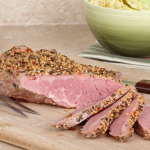Corned be ef is a salt-cured beef product. The term comes from the treatment of the meat with large grained rock salt, also called “corns” of salt. It features as an ingredient in many cuisines, including British, Irish-American, Jewish, Caribbean, Philippine cuisine and Chamorro cuisine (Mariana Islands such as Saipan and Guam)
ef is a salt-cured beef product. The term comes from the treatment of the meat with large grained rock salt, also called “corns” of salt. It features as an ingredient in many cuisines, including British, Irish-American, Jewish, Caribbean, Philippine cuisine and Chamorro cuisine (Mariana Islands such as Saipan and Guam)
It was popular during both World Wars, when fresh meat was rationed. Corned beef remains popular in the United Kingdom and countries with British culinary traditions and is commonly used in sandwiches, corned beefhash or eaten with chips and pickles. It also remains especially popular in Canada in a variety of dishes, perhaps most prominently Montreal smoked meat.
Although the exact beginnings of corned beef are unknown, it most likely came about when people began preserving meat through salt-curing. Evidence of its legacy is apparent in numerous cultures, including Ancient Europe and the Middle East. The word corn derives from Old English, and is used to describe any small hard particles or grains. In the case of “corned beef”, the word may refer to the coarse granular salts used to cure the beef. The word corned may also refer to the corns of potassium nitrate, also known as saltpetre (and one of the main ingredients in gunpowder), which were formerly used to preserve the meat.
In North America corned beef dishes are associated with traditional Irish cuisine. However there is considerable debate about the association of corned beef with Ireland. Mark Kurlansky, in his book Salt, states that the Irish produced a salted beef around the Middle Ages that was the “forerunner of what today is known as Irish corned beef” and in the 17th century the English named the Irish salted beef “corned beef”. Some say it was not until the wave of 18th century Irish immigration to the United States that much of the ethnic Irish first began to consume corned beef dishes as seen today. The popularity of corned beef compared to bacon among the immigrant Irish may have been due to corned beef being considered a luxury product in their native land, while it was cheaply and readily available in America.
In Ireland today, the serving of corned beef is geared toward tourist consumption and most Irish in Ireland do not identify the ingredient as native cuisine.
The Jewish population produced similar koshered cured beef product made from the brisket which the Irish immigrants purchased as corned beef from Jewish butchers. This may have been facilitated by the close cultural interactions and collaboration of these two diverse cultures in the USA’s main 19th and 20th century immigrant port of entry, New York City.
Source: Wikipedia
This is the Chefelle Method of making a tender Corned Beef: Buy either the Flat Cut (minimal fat) or the Point (tip) Cut which has more flavor.
Place your corned beef in a pot, add the seasoning packet if provided and add water, submerging the brisket about halfway through. Bring to a boil and continue boiling for about 3-4 hours, adding water as needed. You can choose to place a lid on the pot or not, but just make sure that water doesn’t evaporate too much. The trick is that this is such a tough piece of meat that this high rolling boil for 3-4 hours finally releases the elasticity of the meat and then it’s as soft and tender as can be. Add the quartered cabbage the last 15 minutes of cooking. And remember to sliced your corned beef AGAINST the grain



